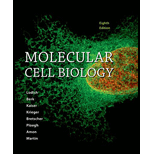
Concept explainers
To analyze:
The definition of genes and state whether they are continuous, simple or complex transcription units for eukaryotes, continuous introns and those capable of making only single proteins from a given gene.
Introduction:
Gene is the basic unit of DNA or chromatin material that contains information about the synthesis of proteins inside a cell. It is also called the hereditary unit of a cell as it helps to transfer characters from parents to offspring.
Explanation of Solution
Gene is the DNA sequence required for the transcription of a functional mRNA is called a gene. It is the hereditary unit of a cell as it is responsible for the transfer of characters from parents to offspring.
Eukaryotes have both simple and complex types of transcriptional units. Simple transcription units are the ones that transcribe for a single type of mRNA, which translates for a single protein. Complex transcription units can produce more than one type of mRNA and therefore more than one type of proteins.
Both simple and complex transcription units can have introns. The only difference is that simple transcription units produce a single protein and all the introns are spliced out while the complex transcriptional units can produce more than one type of mRNA as a result of alternative splicing.
Continuous genes do not have any introns and therefore are capable of a single protein from a given gene.
Genes are the sequence of DNA that is required for producing a functional mRNA. The continuous transcriptional unit does not have any introns and produces a single mRNA. Introns are non-coding sequences that are present in an mRNA that is removed during splicing. Simple transcription units produce a single mRNA by removal of introns while complex transcriptional units can produce more than one types of mRNA by alternative splicing.
Want to see more full solutions like this?
 Human Anatomy & Physiology (11th Edition)BiologyISBN:9780134580999Author:Elaine N. Marieb, Katja N. HoehnPublisher:PEARSON
Human Anatomy & Physiology (11th Edition)BiologyISBN:9780134580999Author:Elaine N. Marieb, Katja N. HoehnPublisher:PEARSON Biology 2eBiologyISBN:9781947172517Author:Matthew Douglas, Jung Choi, Mary Ann ClarkPublisher:OpenStax
Biology 2eBiologyISBN:9781947172517Author:Matthew Douglas, Jung Choi, Mary Ann ClarkPublisher:OpenStax Anatomy & PhysiologyBiologyISBN:9781259398629Author:McKinley, Michael P., O'loughlin, Valerie Dean, Bidle, Theresa StouterPublisher:Mcgraw Hill Education,
Anatomy & PhysiologyBiologyISBN:9781259398629Author:McKinley, Michael P., O'loughlin, Valerie Dean, Bidle, Theresa StouterPublisher:Mcgraw Hill Education, Molecular Biology of the Cell (Sixth Edition)BiologyISBN:9780815344322Author:Bruce Alberts, Alexander D. Johnson, Julian Lewis, David Morgan, Martin Raff, Keith Roberts, Peter WalterPublisher:W. W. Norton & Company
Molecular Biology of the Cell (Sixth Edition)BiologyISBN:9780815344322Author:Bruce Alberts, Alexander D. Johnson, Julian Lewis, David Morgan, Martin Raff, Keith Roberts, Peter WalterPublisher:W. W. Norton & Company Laboratory Manual For Human Anatomy & PhysiologyBiologyISBN:9781260159363Author:Martin, Terry R., Prentice-craver, CynthiaPublisher:McGraw-Hill Publishing Co.
Laboratory Manual For Human Anatomy & PhysiologyBiologyISBN:9781260159363Author:Martin, Terry R., Prentice-craver, CynthiaPublisher:McGraw-Hill Publishing Co. Inquiry Into Life (16th Edition)BiologyISBN:9781260231700Author:Sylvia S. Mader, Michael WindelspechtPublisher:McGraw Hill Education
Inquiry Into Life (16th Edition)BiologyISBN:9781260231700Author:Sylvia S. Mader, Michael WindelspechtPublisher:McGraw Hill Education





